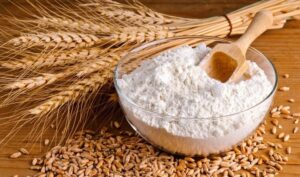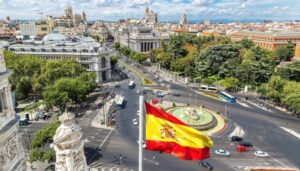
For the first time in 2025, a separate annual quota for the supply of 30,000 tons of Ukrainian flour to the European Union has been granted, which opens up opportunities for long-term planning for the domestic flour milling business, said Rodion Rybchinsky, director of the Ukrainian Flour Millers Association.
“The top 10 export-oriented companies have already invested around EUR 17 million in modernization and now understand that these investments will have prospects,” he said at the “Agribusiness in Ukraine” conference in Kyiv on Thursday.
He recalled that until 2022, flour was exported within the joint quota with wheat. Flour millers usually did not have time to deliver their products to the EU, as grain traders were the first to choose the quota. Only after the opening of trade preferences in 2022 did Ukrainian flour begin to actively enter the EU market, and in 2023, flour exports to EU countries amounted to 73,000 tons.
“These volumes became an argument in the negotiations: if 73,000 tons were successfully delivered to the EU, the question of Ukrainian flour’s non-compliance with European quality requirements would be moot,” said Rybchynskyi.
According to him, Ukrainian flour is now available in Germany, the Czech Republic, Spain, and Italy, which is clear proof of the high quality of Ukrainian products.
Rybchynskyi noted that during the 11 months of 2025, Ukraine supplied 26,000 tons of this product to the EU, so by the end of the year, domestic producers will be able to fully use the quota. At the same time, the biggest problem for flour millers in 2026, if we assess the prospects of the industry, will be the labor shortage.
He named the European Millers’ Congress in France as one of the most anticipated events in the industry next year, during which the Ukrainian side will try to find arguments and establish contact, in particular, with the Romanian Association of Flour Producers, as well as try to lay the groundwork for a review of quotas in 2028. According to Rybchynsky’s estimates, Ukraine is capable of supplying 300,000 tons of flour to the EU market.

The Ukrainian Unity Hub in Spain will open in the city of Torrevieja in the province of Alicante, according to the Ministry of Social Policy, Family, and Unity.
“We are grateful to the Spanish side for supporting our citizens, as well as for the decision to transfer premises for the Ukrainian Unity Hub in Torrevieja,” the press service quoted Deputy Minister of Social Policy Ilona Gavronska as saying following a working visit to Spain.
It is noted that during this visit, she met with the Ukrainian community, where the concept of the Unity Network was presented and discussed with the participants of the event.
The ministry noted that almost a quarter of all Ukrainians with temporary protection status in Spain live in the province of Alicante.
As reported, on January 24, the Cabinet of Ministers approved the creation of the Agency for National Unity, a structure that will help implement initiatives for interaction with the Ukrainian community and public organizations in the countries of residence. It was noted that the Agency will open departments in key countries of residence of Ukrainians, primarily in Germany, Poland, and the Czech Republic, and Unity Hubs will be created in the capitals of these countries. The Unity Hub’s functions and capabilities include: an educational and cultural space, language courses, a return consultant, consular services (as an external service), banking services, postal services, an economic opportunities coordinator, DP “Document,” opinion leader meetings, programs for children and youth, a Ukrainian coffee shop, a business hub and coworking space, and a UA Job Center.
In February, a joint declaration of intent was signed to open the first Ukrainian Unity Hub in Berlin. There are plans to open such hubs in Munich and Düsseldorf.
In March, joint declarations of intent were signed to open Ukrainian Unity Hubs in France and Spain.
In early November, the Ministry of Social Policy announced that Ukrainian Unity Hubs would open in Spain, Germany, and the Czech Republic in 2025.

In January–June 2025, foreigners purchased 71,155 homes in Spain, which is 2% more than a year earlier; with their transactions accounting for 19.3% of all home sales, according to the Spanish Notary Council. The British lead the way with 5,731 transactions, followed by Morocco with 5,654 and Germany with 4,756, according to notaries.
Among the nationalities that showed historic highs was Ukraine: in the first half of the year, 2,165 home purchases by Ukrainian citizens were registered, which was a record for the series of observations. Citizens of the US, Portugal, Italy, Morocco, Colombia, and the Netherlands also set new records.
According to notarial statistics, the main concentration of transactions with foreigners is recorded in the coastal provinces and islands—Alicante, the Balearic Islands, Malaga, and Santa Cruz de Tenerife. The market continues to show price differences: American buyers paid an average of €3,465 per square meter, the highest among foreigners; Ukrainians paid around €1,832 per square meter, and Moroccans paid €747 per square meter.
According to notaries and the regional press, purchases by Russians fell by 17.4% and remain below pre-crisis levels; they did not feature among the top nationalities in terms of the number of transactions.

According to an analytical report by Relocation, the average price of secondary housing in Spain reached a historic high of €2,555 per square meter in October 2025, which is 15.7% more in annual terms and 1.5% more than in September. In some markets, the growth was even higher: in the province of Malaga, the average price of secondary housing rose to €3,842 per square meter in August, +13.8% year-on-year. The INE’s nationwide housing price index for the second quarter recorded +12.7% year-on-year, with secondary housing rising by 12.8%.
Prices in Spain are being driven by a shortage of supply, high demand in coastal provinces and on the islands, and sustained activity from foreign buyers. According to Relocation, up to 80% of potential buyers face the problem of affordability and a lack of suitable properties, which further pushes prices up.
The leaders in terms of regional dynamics are the Costa del Sol, the Balearic and Canary Islands, and the provinces of Alicante and Valencia. In the large agglomerations of Madrid and Barcelona, demand is sustained by the rental market and limited construction.
Spanish business publications forecast further growth of 4-6% for 2025-2026, with a shortage of new supply on the market.

Spain’s GDP grew by 0.6% in the third quarter of 2025 compared to the previous three months, according to preliminary data from the national statistics agency INE. Economic growth compared to the same period last year was 2.8%.
Analysts had forecast an average increase of 0.6% for the first indicator and 3% for the second.
The pace of growth slowed: in the second quarter, GDP rose by 0.8% quarter-on-quarter and 3.1% year-on-year.
Consumer spending in Spain rose by 1.2% in July-September compared to the previous quarter, business investment by 1.7%, and government spending by 1.1%.
Exports of goods and services fell by 0.6%, while imports rose by 1.1%.
Industrial production rose by 0.5%. The services sector showed an increase of 0.8%, and the construction industry also rose by 0.8%.
http://relocation.com.ua/vvp-ispanii-v-iii-kvartali-zris-lyshe-na-06/

Spain has agreed to join the PURL project to purchase American weapons for Ukraine, Prime Minister Pedro Sánchez said in response to renewed criticism from US President Donald Trump over Spain’s unwillingness to increase military spending.
“We are a reliable country,” Sanchez said upon arrival at the European Council, where he also confirmed that Spain would purchase weapons from the US for Ukraine, El Pais reported on Thursday.
According to the publication, the country will participate in the US arms supply program (PURL), but the exact amount that Madrid is willing to spend has not yet been determined.